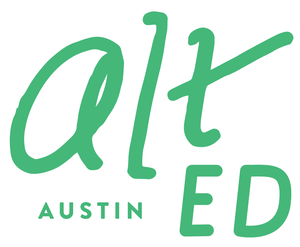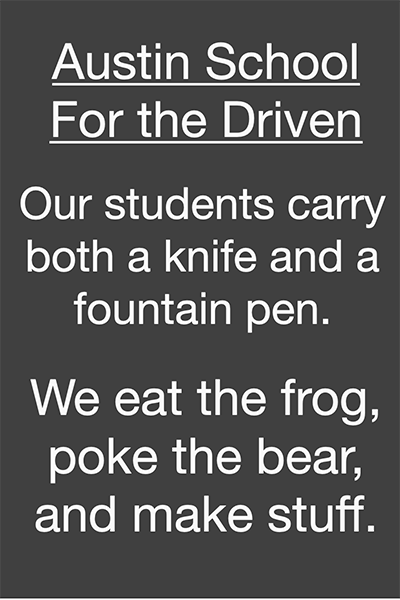Nurturing young writers and entrepreneurs through NaNoWriMo
/Staffmembers at The Joule School in Cedar Park, just north of Austin, join us on the blog today to explain the school’s approach to National Novel Writing Month and the ways it has changed how its young students view writing, entrepreneurship, and themselves.
When first-grader Ripley Martinez walked into a school assembly, she had no idea she would soon be showered in cash. Within 30 minutes, she was jumping up and down with joy as $76—all her own—rained down around her onto the floor.
Ripley celebrates her writing and entrepreneurial achievements at The Joule School’s NaNoWriMo kickoff
That's how much Ripley made selling her novel since last November. You read that correctly: a 5-year-old had written and marketed her own book. Even more impressive, Ripley’s book, Lollipop Girl in a Lollipop World, had just broken the school’s record for number of copies sold. She was surrounded by cheering classmates engulfing her with hugs, and her teacher was crying with pride.
The Joule School, a progressive K–8th private school in Cedar Park, participates each year in the National Novel Writing Month (NaNoWriMo) Young Writers Program. You might be familiar with the adult competition, in which anyone can attempt to write a 50,000-word novel in 30 days. The NaNoWriMo organization offers suggested word-count goals and a certificate for grade-school students who complete a modified version of the competition.
The Joule School does NaNoWriMo in a big way. First, it raises the bar—increasing the word count minimum for their students by up to 3,000 words per grade level. Suggested word-count goals for Kindergarten, when Ripley wrote her book, range from 20 to 200 words, but she was encouraged to hit 500. (This is equivalent to the “advanced” category for second-grade students in the national program.) If students rise to the challenge, Joule celebrates by arranging to have their hard work published and placed for sale on Amazon. Then, at the beginning of every November, authors from the previous year are recognized at an awards ceremony and handed cold, hard cash—their royalties from a year’s worth of online sales.
Of course, merely placing the book on Amazon doesn’t sell copies. Ripley publicized her book all over Austin, wherever she went. Her mother reported, “I went to get my oil changed and stepped outside for a few seconds. When I came back, Ripley was encouraging the receptionist to buy her novel.” (She even went behind the desk and pulled up the link to make the checkout process easier!) Her sales pitch was simple: “Can you please buy my book? It’s on sale on Amazon if you look up ‘Ripley Martinez.’” Determination and a dash of innate childlike charm did the trick, and now Ripley has 76 more bucks to spend on “Hatchimals, LOL Dolls, and . . . more books.”
Ripley’s novel is about “a candy girl adventuring and finding her friends,” according to the young author. When asked where she derived her inspiration, she said simply, “Candy.” (A glimpse into the mysterious creative processes of a visionary.) Her teacher, Meredith Allen, said Ripley was encouraged by meeting—and then exceeding—her incremental word-count goals. All over the school, individual floor-to-ceiling progress trackers (similar to a fundraising thermometer) were plastered on the walls. At the end of each day, Ms. Allen would type up her students’ handwritten work and let them check their totals. (Incidentally, this is not unlike Margaret Atwood’s writing process.) She says the students felt gratified when they used the word-count tool to see how much they had accomplished each day. It quantifies their success in a way that is readily accessible to them.
Students’ published works on display at The Joule School
The Joule School’s approach to NaNoWriMo develops more than just literacy skills. As the students complete the process, they learn about gross versus net income, active versus passive income, marketing, and other elements of entrepreneurship. The entire student body, from three-year-olds to eighth-graders about to matriculate to high school, can opt in. Ripley’s novel grossed $285 in 12 months, but she knew she would have to pay publishing costs and taxes. She also knew that the money she would get on November 1st was all her own, free and clear. What better way to teach a young child about net profit?
More importantly, however, students at The Joule School associate joy, achievement, and success with the act of writing—something that can be a hard sell in the elementary grades. “I’ve seen kids go from reluctant writers to enthusiastic just by completing one round of NaNoWriMo,” said Madison McWilliams, the school’s founder and principal. “You see their whole attitude change—it’s suddenly I CAN do this. Once they start believing in themselves, we can roll that over to the classroom. Suddenly the kid who wasn’t such a huge fan of writing is the most attentive student in Language Arts.”
These days, Ripley often chooses her own book to read as her bedtime story. In doing so, she generates new ideas and thinks of ways she could improve her writing. One year later, she’s decided to tackle a more complex subject: this November, she’s working on a rags-to-riches tale of redemption about a young girl living in poverty. Soon, you’ll see it on Amazon. Soon, you might just see a young girl around town asking you to buy her second book.
The Joule School staff






















